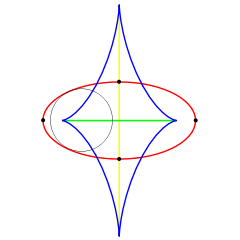Symmetry set

In geometry, the symmetry set is a method for representing the local symmetries of a curve, and can be used as a method for representing the shape of objects by finding the topological skeleton. The medial axis, a subset of the symmetry set is a set of curves which roughly run along the middle of an object.
The symmetry set in 2 dimensions
Let  be an open interval, and
be an open interval, and  be a parametrisation of a smooth plane curve.
be a parametrisation of a smooth plane curve.
The symmetry set of  is defined to be the closure of the set of centres of circles tangent to the curve at at least two distinct points (bitangent circles).
is defined to be the closure of the set of centres of circles tangent to the curve at at least two distinct points (bitangent circles).
The symmetry set will have endpoints corresponding to vertices of the curve. Such points will lie at cusp of the evolute. At such points the curve will have 4-point contact with the circle.
The symmetry set in n dimensions
For a smooth manifold of dimension  in
in  (clearly we need
(clearly we need  ). The symmetry set of the manifold is the closure of the centres of hyperspheres tangent to the manifold in at least two distinct places.
). The symmetry set of the manifold is the closure of the centres of hyperspheres tangent to the manifold in at least two distinct places.
The symmetry set as a bifurcation set
Let  be an open simply connected domain and
be an open simply connected domain and  . Let
. Let  be a parametrisation of a smooth piece of manifold.
We may define a
be a parametrisation of a smooth piece of manifold.
We may define a  parameter family of functions on the curve, namely
parameter family of functions on the curve, namely
This family is called the family of distance squared functions. This is because for a fixed  the value of
the value of  is the square of the distance from
is the square of the distance from  to
to  at
at 
The symmetry set is then the bifurcation set of the family of distance squared functions. I.e. it is the set of  such that
such that  has a repeated singularity for some
has a repeated singularity for some 
By a repeated singularity, we mean that the jacobian matrix is singular. Since we have a family of functions, this is equivalent to  .
.
The symmetry set is then the set of  such that there exist
such that there exist  with
with  , and
, and
together with the limiting points of this set.
References
1. J. W. Bruce, P.J.Giblin and C. G. Gibson, Symmetry Sets. Proc. of the Royal Soc.of Edinburgh 101A (1985), 163-186.
2. J. W. Bruce and P.J.Giblin, Curves and Singularities, Cambridge University Press (1993).

